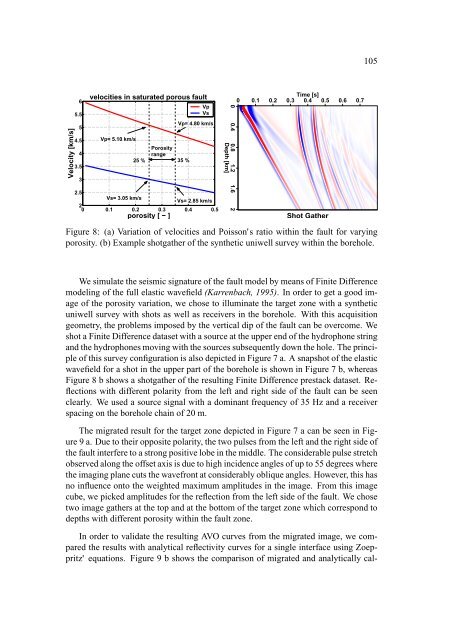Annual Report 2000 - WIT
Annual Report 2000 - WIT
Annual Report 2000 - WIT
You also want an ePaper? Increase the reach of your titles
YUMPU automatically turns print PDFs into web optimized ePapers that Google loves.
105<br />
Velocity [km/s]<br />
6<br />
5.5<br />
5<br />
4.5<br />
4<br />
3.5<br />
3<br />
velocities in saturated porous fault<br />
Vp= 5.10 km/s<br />
Porosity<br />
range<br />
25 % 35 %<br />
2.5<br />
Vs= 3.05 km/s<br />
Vs= 2.85 km/s<br />
2<br />
0 0.1 0.2 0.3 0.4 0.5<br />
porosity [ − ]<br />
Vp<br />
Vs<br />
Vp= 4.80 km/s<br />
0 0.4 0.8 1.2 1.6 2<br />
Depth [km]<br />
Time [s]<br />
0 0.1 0.2 0.3 0.4 0.5 0.6 0.7<br />
Shot Gather<br />
Figure 8: (a) Variation of velocities and Poisson's ratio within the fault for varying<br />
porosity. (b) Example shotgather of the synthetic uniwell survey within the borehole.<br />
We simulate the seismic signature of the fault model by means of Finite Difference<br />
modeling of the full elastic wavefield (Karrenbach, 1995). In order to get a good image<br />
of the porosity variation, we chose to illuminate the target zone with a synthetic<br />
uniwell survey with shots as well as receivers in the borehole. With this acquisition<br />
geometry, the problems imposed by the vertical dip of the fault can be overcome. We<br />
shot a Finite Difference dataset with a source at the upper end of the hydrophone string<br />
and the hydrophones moving with the sources subsequently down the hole. The principle<br />
of this survey configuration is also depicted in Figure 7 a. A snapshot of the elastic<br />
wavefield for a shot in the upper part of the borehole is shown in Figure 7 b, whereas<br />
Figure 8 b shows a shotgather of the resulting Finite Difference prestack dataset. Reflections<br />
with different polarity from the left and right side of the fault can be seen<br />
clearly. We used a source signal with a dominant frequency of 35 Hz and a receiver<br />
spacing on the borehole chain of 20 m.<br />
The migrated result for the target zone depicted in Figure 7 a can be seen in Figure<br />
9 a. Due to their opposite polarity, the two pulses from the left and the right side of<br />
the fault interfere to a strong positive lobe in the middle. The considerable pulse stretch<br />
observed along the offset axis is due to high incidence angles of up to 55 degrees where<br />
the imaging plane cuts the wavefront at considerably oblique angles. However, this has<br />
no influence onto the weighted maximum amplitudes in the image. From this image<br />
cube, we picked amplitudes for the reflection from the left side of the fault. We chose<br />
two image gathers at the top and at the bottom of the target zone which correspond to<br />
depths with different porosity within the fault zone.<br />
In order to validate the resulting AVO curves from the migrated image, we compared<br />
the results with analytical reflectivity curves for a single interface using Zoeppritz'<br />
equations. Figure 9 b shows the comparison of migrated and analytically cal-







